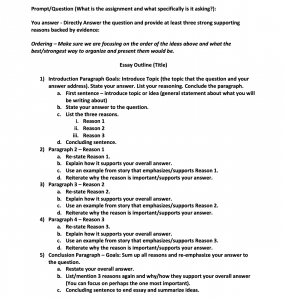Informational Writing. Two words bound to lose the attention of any kid (and probably just about every adult) the second they’re uttered…It’s not a phrase that’s quite conducive to awe, wonder, or excitement. And outside of battling a lack of interest, writing itself can be a tedious, frustrating, and scary process that most students do everything they can to avoid.
So what can we do? How can we get past all of the barriers that children and students put up for us and for themselves?
As is so often the case with writing, informational writing assignments require us to follow a conscious process. It can be challenging for middle school students to meticulously follow (let alone create) certain processes, make sure nothing has been left out, provide relevant details, and remain focused on the overall goal. That is a challenging task for anyone, let alone a 4th or 5th grade student.
In order to make that process easier, we need to break it down into smaller, more manageable pieces, each with clearly established and straightforward goals:
PART 1
PREPARATION – Understand the Assignment + Create a Plan
PART 2
DRAFTING – Research, Record, and Organize Relevant Ideas and Details
PART 3
EVALUATION and REVIEW – Evaluate, Share, Revise, Proofread, and Edit
This article will cover part one in a three-part series that breaks down that process and details what should be accomplished at each stage.
PART 1 – Preparation
Help them Understand the Assignment + Create a Plan
What is information writing? – Make sure they have a clear understanding of what it is and what the goal/purpose of the assignment is as well.
Without a comprehensive understanding of both the requirements and goal(s) of the assignment, students will never have a chance to truly engage with the assignment and its content. To address this crucial step, we need to ask the right questions:
Help them Understand the Assignment
What is the assignment? (What type of assignment?)
What are the requirements? (What needs to be included?)
What is the overall goal?
Ensuring that your child can answer all of these questions confidently will allow them to successfully execute the assignment
What is the assignment?
Informational writing. Out of all of the types of writing assignments that are out there, informational tends to be one of the most straightforward. Informational assignments should answer questions of how or why. Unlike persuasive or argumentative writing, we are not trying to convince or change anyone’s mind, but rather to provide information. The content should educate the reader or audience by presenting straightforward information on a specific topic, in a clear and structured manner.
What are the requirements? (What needs to be included?)
This will depend on the specific instructions that the teacher gives to students. This is where it is important to take the time to emphasize the importance of comprehending the instructions in their entirety. Some instructions will be simple and straightforward. Others will be dense and complex.
Students should be able to read the instructions and explain in their own words, what the teacher is looking for and what their paper needs to include.
Walking them through this process multiple times is helpful. Break the instructions apart. Help them to analyze what language in the instructions is a call to action, requirement, suggestion, etc. For more complicated instructions, it can be very helpful to deconstruct the instructions into a clear task list that includes each one of the requirements as laid out by the teacher. Visualizing requirements in this format helps students to more quickly reference and remember the most important tasks and stay focused throughout the process.
What is the overall goal?
The primary goal of informational writing is to increase the amount of knowledge the audience or reader has on our specific topic.
Students need to understand the purpose and goal of every assignment they undertake. This is especially true when it comes to writing. Without an understanding of the assignment’s purpose, it is impossible for any student to develop a confident sense of direction for their writing. This can inhibit every single step of the process and lead to a lot of resistance and foot dragging.
To reiterate from earlier, a final product for an informational writing piece should present straightforward information on a specific topic, in a clear and structured manner.
Create a Plan
Now that we understand what is being asked of us, it is time to figure out how we are going to get there.
To do that we need to create a plan. Beating a dead horse, I know…but this is ESSENTIAL, especially in writing. It helps to affirm the student’s sense of direction and create a clear roadmap of what tasks need to be completed and in what order to have a complete paper.
There are three keys to creating a solid writing plan:
- Gathering Materials
- Planning Time
- CREATE AN OUTLINE
Gathering Materials – make sure that your child or student has all of the resources necessary to complete the assignment. Whether this means pencils and erasers, or computer time and books from the library, make sure they know what they need and have a plan for gathering the necessary materials as early as possible.
Planning Time – What does the student’s schedule look like? It can be a great challenge for middle school students to plan their weeks by the day and their days by the hour. Writing assignments are often completed over the course of at least a few days. Set interim deadlines for specific tasks (chance to learn accountability).
CREATE AN OUTLINE – If the teacher has not provided a visual outline for students to fill out and complete, it is important that they know how to create one for themselves. Learning to properly outline is a skill that students will take far beyond middle school.
A simple five paragraph essay outline structure should do just fine for nearly any middle school writing assignment. I’ve included a picture of a generic outline I created, but remember, outlines should always be adapted and adjusted to fit the specific assignment/prompt:
Once the outline has been created, you have completed Part 1! Tedious, yes I know. But that is a part of how good writing is created and good habits are formed. The more the process is repeated, the less tedious and more natural it will become. Plus, I have good news…Parts 2 and 3 are actually a lot easier because of all the groundwork we laid in Part 1. Stay tuned for Part 2, when we will take a look at the drafting stage of informational writing.
Nicholas Prutting


